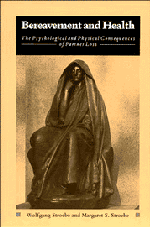Book contents
- Frontmatter
- Contents
- Preface
- 1 Introduction
- 2 The symptomatology of grief
- 3 Is grief universal? Cultural variations in the emotional reactions to loss
- 4 Depression models of grief
- 5 Stress models of grief
- 6 Mediators between stress and illness
- 7 The loss effect: health consequences of marital bereavement
- 8 Risk factors in bereavement outcome
- 9 Reducing the risk of poor bereavement outcome
- References
- Author index
- Subject index
9 - Reducing the risk of poor bereavement outcome
Published online by Cambridge University Press: 03 May 2010
- Frontmatter
- Contents
- Preface
- 1 Introduction
- 2 The symptomatology of grief
- 3 Is grief universal? Cultural variations in the emotional reactions to loss
- 4 Depression models of grief
- 5 Stress models of grief
- 6 Mediators between stress and illness
- 7 The loss effect: health consequences of marital bereavement
- 8 Risk factors in bereavement outcome
- 9 Reducing the risk of poor bereavement outcome
- References
- Author index
- Subject index
Summary
Introduction
In a popular book of etiquette published in England in 1929 the author, a Lady Troubridge (1979), wrote on the customs to observe on the occurrence of a breavement: “One chief rule to remember … is that sorrow is sacred, and that it is one of the most unforgivable breaches of good behaviour to intrude upon it. … The members of the bereaved family should be left as much alone in their grief as possible” (1979, p. 55).
Failure to follow the rule of leaving the bereaved to their own devices was censored by Lady Troubridge as inconsiderate and very ill bred. Indeed, she stated, the bereaved should be left to themselves precisely because they are in danger of breaking down and showing unseemly emotion: “It is difficult to keep a firm hold over the emotions at such a time, and it is therefore wiser to see no one if there is a chance of breaking down” (1979, p. 57). The view that the bereaved must be left well alone by all but their closest circle of similarly grieving relatives is no longer a firm rule of contemporary Western society. It has become well accepted that others can help the bereaved and alleviate their psychological and physical suffering. On a more formal level, this follows from our own theoretical perspective (see Chapter 5), which argued that interpersonal variables are critical not only as determinants of the intensity of symptoms and duration of grief, but also of the ultimate health outcome following bereavement.
- Type
- Chapter
- Information
- Bereavement and HealthThe Psychological and Physical Consequences of Partner Loss, pp. 224 - 249Publisher: Cambridge University PressPrint publication year: 1987



